Demand and Supply Purchasing Power of Money &














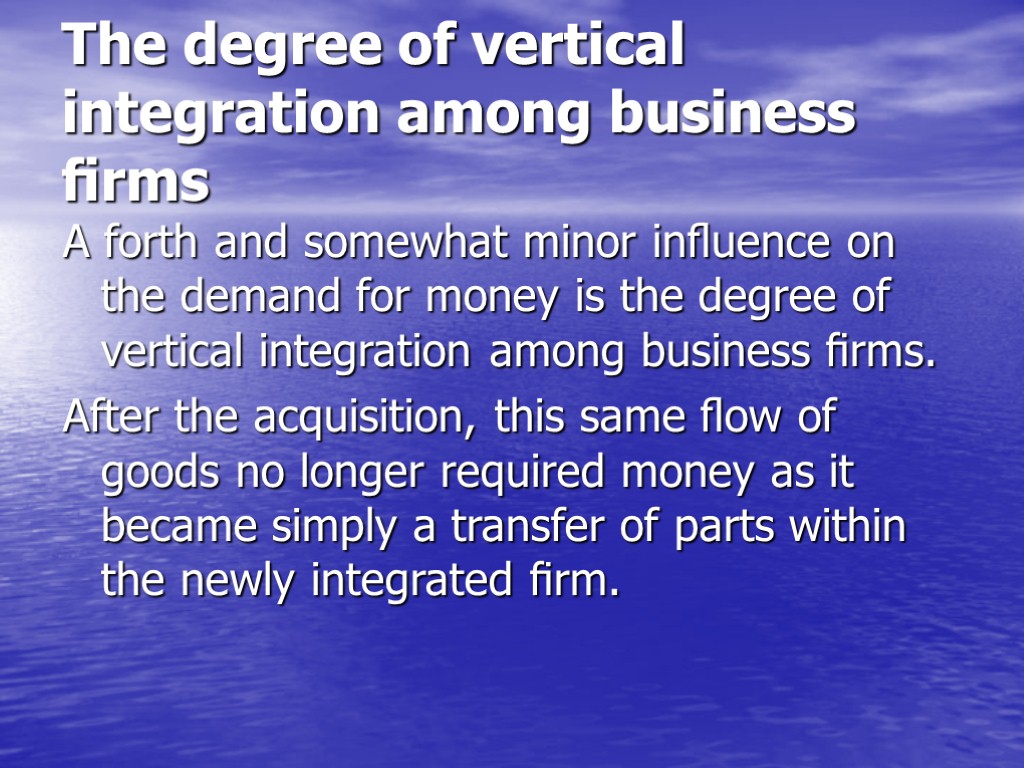




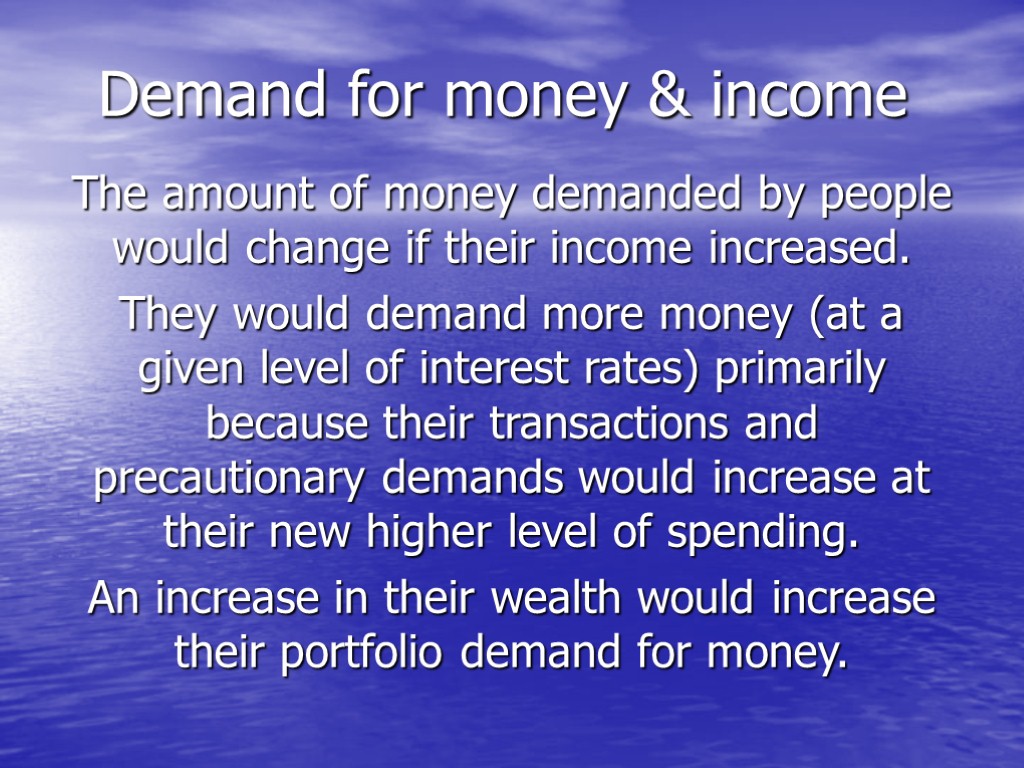












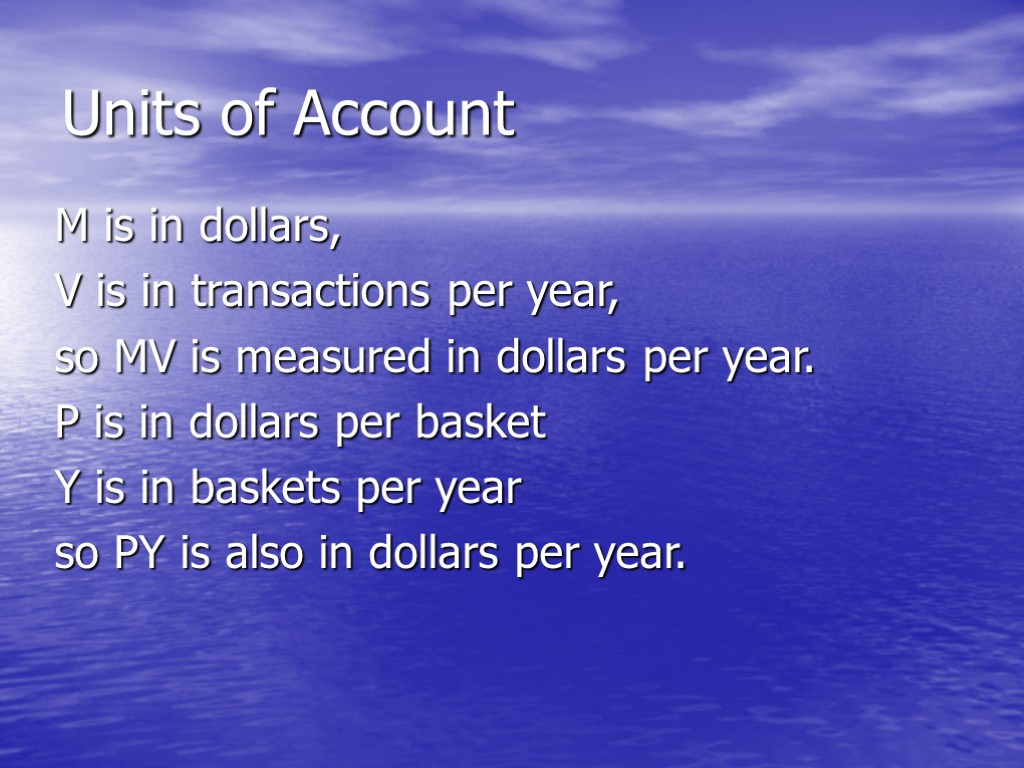




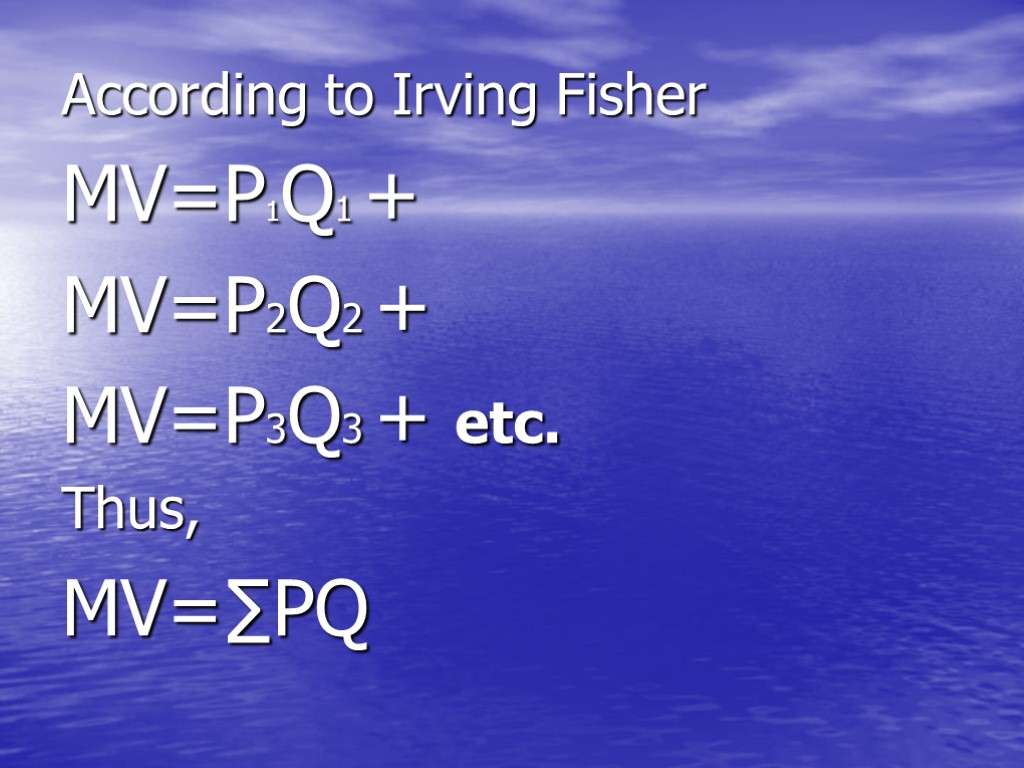
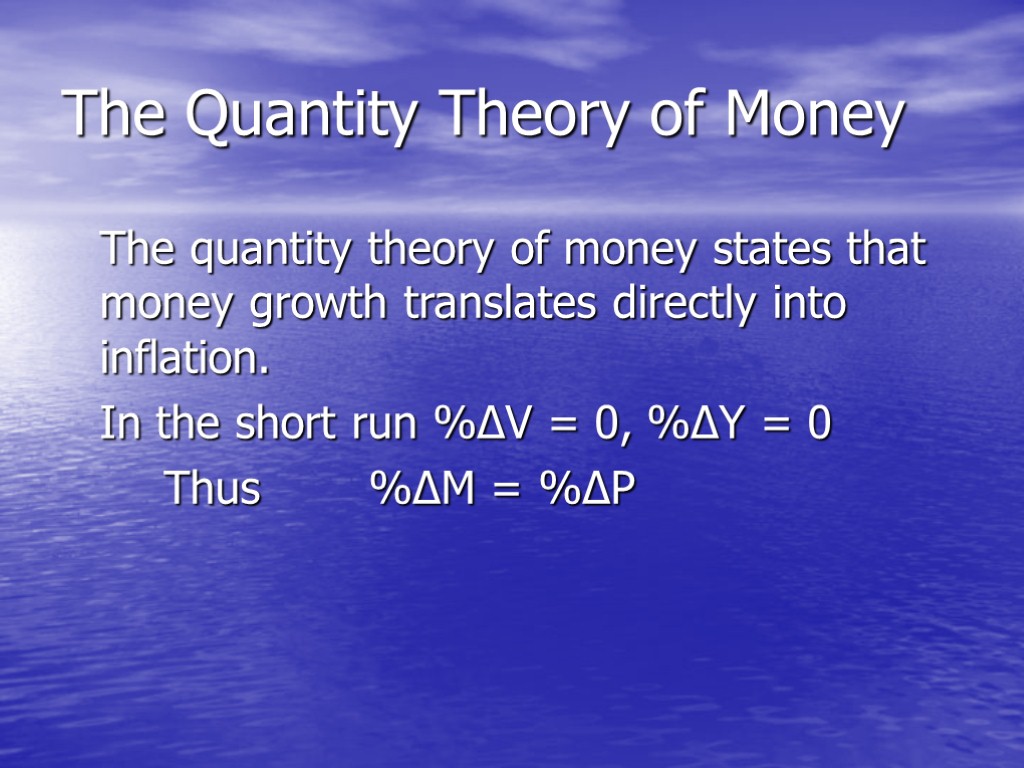


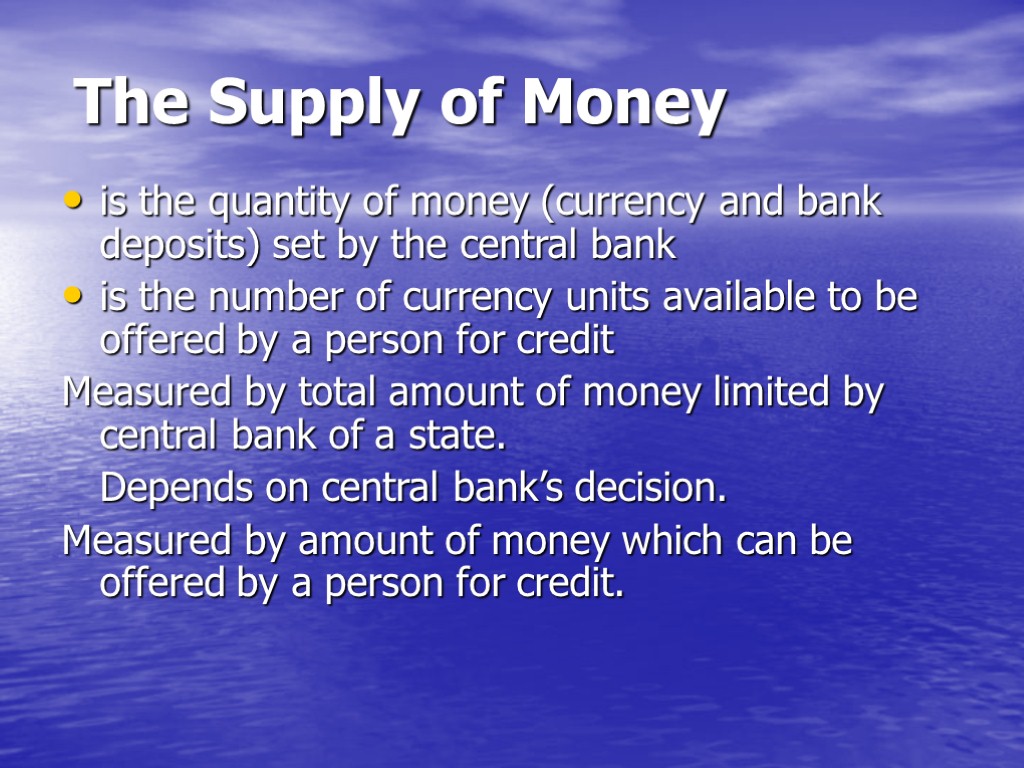


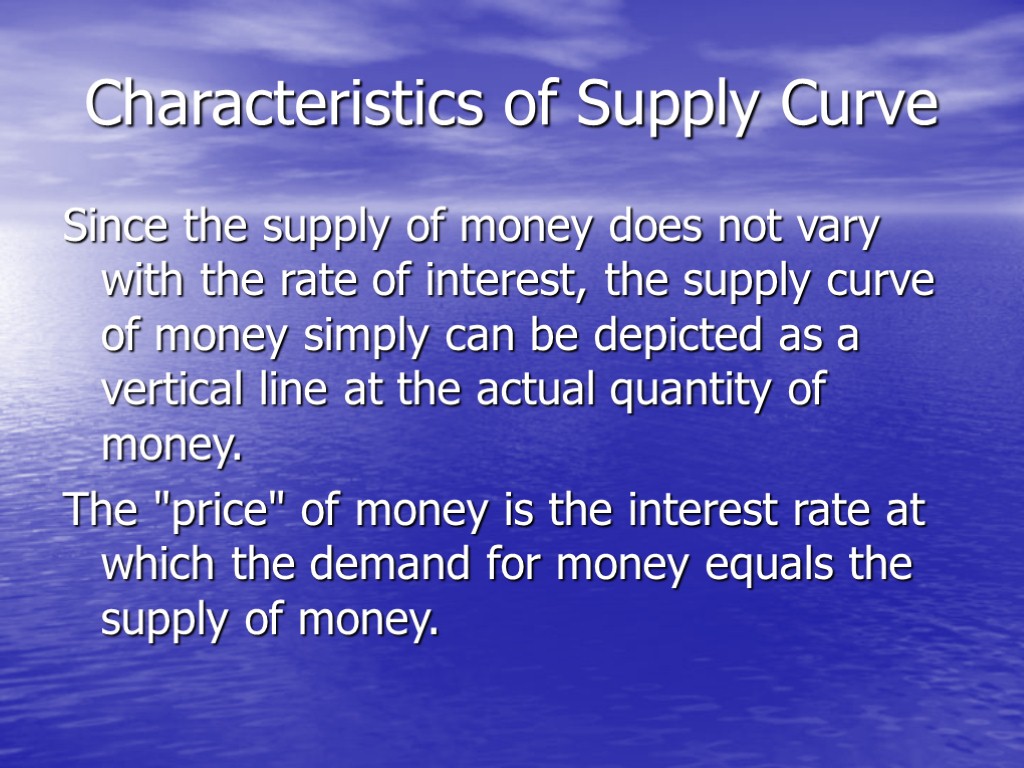








demand_and_supply.ppt
- Количество слайдов: 52
 Demand and Supply Purchasing Power of Money & inflation Demand for Money Velocity and Equation of Exchange Supply of Money
Demand and Supply Purchasing Power of Money & inflation Demand for Money Velocity and Equation of Exchange Supply of Money
 The Purchasing Power of Money The price level P is measured in units of dollars per basket. When the price level rises, the purchasing power of a unit of money declines. The purchasing power of money, abbreviated PPM, is defined as the reciprocal of the price level, 1/P, in units of baskets per dollar.
The Purchasing Power of Money The price level P is measured in units of dollars per basket. When the price level rises, the purchasing power of a unit of money declines. The purchasing power of money, abbreviated PPM, is defined as the reciprocal of the price level, 1/P, in units of baskets per dollar.
 Inflation The absolute price level at any given time is not as interesting as changes in P that are observed over time. A rise in the price level is called price inflation (or just inflation). A decline is called price deflation (or just deflation). A slowing of price inflation is called disinflation.
Inflation The absolute price level at any given time is not as interesting as changes in P that are observed over time. A rise in the price level is called price inflation (or just inflation). A decline is called price deflation (or just deflation). A slowing of price inflation is called disinflation.
 Indices of Inflation Consumer Price Index (CPI) “producer price index” (PPI) “GDP deflator” They generally correlate well with each other
Indices of Inflation Consumer Price Index (CPI) “producer price index” (PPI) “GDP deflator” They generally correlate well with each other
 Consumer Price Index - is a collection of goods and services developed to replicate the spending patterns of consumers. The items in the CPI do not carry equal weight but are assigned quantities that are supposed to represent the allocation of a typical consumer’s income.
Consumer Price Index - is a collection of goods and services developed to replicate the spending patterns of consumers. The items in the CPI do not carry equal weight but are assigned quantities that are supposed to represent the allocation of a typical consumer’s income.
 Producer price index (PPI) purports to represent the costs faced by typical producers
Producer price index (PPI) purports to represent the costs faced by typical producers
 “GDP deflator” attempts to measure the prices of all the goods and services produced in the entire national economy, its “gross domestic product.”
“GDP deflator” attempts to measure the prices of all the goods and services produced in the entire national economy, its “gross domestic product.”
 Annual rates of change of three price indices
Annual rates of change of three price indices
 The Law of Demand for Money The law of demand says that as the price of something declines, people demand more of it, and this is true for money. Money’s purchasing power is its price, equal to the reciprocal of the price level: PPM=1/P. When the purchasing power of money declines (and the price level rises) we want to hold more money, other things being equal. We desire money only because we can buy things with it, and we need more to acquire the same goods and services when money’s purchasing power declines.
The Law of Demand for Money The law of demand says that as the price of something declines, people demand more of it, and this is true for money. Money’s purchasing power is its price, equal to the reciprocal of the price level: PPM=1/P. When the purchasing power of money declines (and the price level rises) we want to hold more money, other things being equal. We desire money only because we can buy things with it, and we need more to acquire the same goods and services when money’s purchasing power declines.
 Types of Demand for Money The desire to acquire money to be spent immediately (or in the near future) is called transactions demand. Money desired for expenditure later is a form of saving, and is called portfolio demand.
Types of Demand for Money The desire to acquire money to be spent immediately (or in the near future) is called transactions demand. Money desired for expenditure later is a form of saving, and is called portfolio demand.
 Transactions Demand for Money First, people demand more money to hold as the supply of goods and services increases, other things being equal. As wealth increases and if people want to hold a constant proportion of their wealth as money, then the amount of money they want to hold must rise.
Transactions Demand for Money First, people demand more money to hold as the supply of goods and services increases, other things being equal. As wealth increases and if people want to hold a constant proportion of their wealth as money, then the amount of money they want to hold must rise.
 Second influence is the cost of acquiring cash. If acquiring cash requires standing in line at a bank, people will keep larger amounts on hand. However, low-income people who lack bank accounts and must rely on costly commercial check-cashing businesses will keep larger amounts of cash relative to their monthly expenditures.
Second influence is the cost of acquiring cash. If acquiring cash requires standing in line at a bank, people will keep larger amounts on hand. However, low-income people who lack bank accounts and must rely on costly commercial check-cashing businesses will keep larger amounts of cash relative to their monthly expenditures.
 Third influence – the clearing system Concerning electronic money… Clearing system efficiencies reduce the demand to hold money.
Third influence – the clearing system Concerning electronic money… Clearing system efficiencies reduce the demand to hold money.
 The degree of vertical integration among business firms A forth and somewhat minor influence on the demand for money is the degree of vertical integration among business firms. After the acquisition, this same flow of goods no longer required money as it became simply a transfer of parts within the newly integrated firm.
The degree of vertical integration among business firms A forth and somewhat minor influence on the demand for money is the degree of vertical integration among business firms. After the acquisition, this same flow of goods no longer required money as it became simply a transfer of parts within the newly integrated firm.
 Portfolio Demand for Money Money is the most liquid form of savings – you can spend it immediately in case an emergency or unexpected opportunity arises. Money saved in a bank or other institution may earn interest, but the rate is usually low. One of the opportunity costs of holding money is the higher interest you could probably earn on less liquid forms of saving.
Portfolio Demand for Money Money is the most liquid form of savings – you can spend it immediately in case an emergency or unexpected opportunity arises. Money saved in a bank or other institution may earn interest, but the rate is usually low. One of the opportunity costs of holding money is the higher interest you could probably earn on less liquid forms of saving.
 Opportunity cost of money The demand for a good or service depends in part on its price or cost. The demand for a good or service depends in part on its price or cost. The cost of holding money is an opportunity cost over time, because the alternative is investing those funds to earn interest. What one gets in return for giving up interest income is the liquidity that money provides. Each of us balances the opportunity cost of holding money with the value of that liquidity.
Opportunity cost of money The demand for a good or service depends in part on its price or cost. The demand for a good or service depends in part on its price or cost. The cost of holding money is an opportunity cost over time, because the alternative is investing those funds to earn interest. What one gets in return for giving up interest income is the liquidity that money provides. Each of us balances the opportunity cost of holding money with the value of that liquidity.
 One more classification of reasons for money demand There are three fundamental reasons as to why people demand money: 1) Transitory demand – the amount of money that you require to settle transactions, since money is the medium of exchange. 2) Precautionary demand – the amount of money required in the event of unexpected need as a precautionary store of liquidity. 3) Speculative demand – the amount of money required for investment opportunities and / or luxury items. People need money to reduce the riskiness of a portfolio of assets by including some money in the portfolio, since the value of money is very stable compared with that of stocks, bonds, or real estate.
One more classification of reasons for money demand There are three fundamental reasons as to why people demand money: 1) Transitory demand – the amount of money that you require to settle transactions, since money is the medium of exchange. 2) Precautionary demand – the amount of money required in the event of unexpected need as a precautionary store of liquidity. 3) Speculative demand – the amount of money required for investment opportunities and / or luxury items. People need money to reduce the riskiness of a portfolio of assets by including some money in the portfolio, since the value of money is very stable compared with that of stocks, bonds, or real estate.
 Demand for money is the amount of money that people desire to hold
Demand for money is the amount of money that people desire to hold
 Demand for money & income The amount of money demanded by people would change if their income increased. They would demand more money (at a given level of interest rates) primarily because their transactions and precautionary demands would increase at their new higher level of spending. An increase in their wealth would increase their portfolio demand for money.
Demand for money & income The amount of money demanded by people would change if their income increased. They would demand more money (at a given level of interest rates) primarily because their transactions and precautionary demands would increase at their new higher level of spending. An increase in their wealth would increase their portfolio demand for money.
 A households' demand for money primarily depends on: the interest rate, their income, and wealth, other variables. Firms are also holders of money, in their cash registers and bank accounts, for essentially the same basic reasons as households.
A households' demand for money primarily depends on: the interest rate, their income, and wealth, other variables. Firms are also holders of money, in their cash registers and bank accounts, for essentially the same basic reasons as households.
 The demand for money can be represented by the following equation: Md = k × P× y Since the primary objective of money demand is expenditure - money demand is a function of expenditure (price × income) k is a part of money, wanted to be held by people
The demand for money can be represented by the following equation: Md = k × P× y Since the primary objective of money demand is expenditure - money demand is a function of expenditure (price × income) k is a part of money, wanted to be held by people
 If income is zero then the demand for money is zero? This is unrealistic because money demand is required for survival (food). So a more appropriate relationship for money demand could be: M d= a + k × P × y where a is an autonomous component of money demand that is independent of the income level.
If income is zero then the demand for money is zero? This is unrealistic because money demand is required for survival (food). So a more appropriate relationship for money demand could be: M d= a + k × P × y where a is an autonomous component of money demand that is independent of the income level.
 The demand for any good or service is usually pictured in economics as a function of its price, holding income and other factors constant. In the case of holding money, the "price" is the opportunity cost of holding one dollar for one year, the interest rate. When we plot the quantity of money demanded on the horizontal axis and the interest rate on the vertical axis we will have a demand curve.
The demand for any good or service is usually pictured in economics as a function of its price, holding income and other factors constant. In the case of holding money, the "price" is the opportunity cost of holding one dollar for one year, the interest rate. When we plot the quantity of money demanded on the horizontal axis and the interest rate on the vertical axis we will have a demand curve.
 Demand curve
Demand curve
 The quantity of money demanded is higher when the interest rate is lower. This inverse relationship between the interest rate and the demand for money just reflects the fact that when the opportunity cost of holding money is low, people will want to hold more of it, and when it is high people will want to hold less of it. At very low levels of the interest rate the quantity of money demanded increases dramatically, meaning that people would then want to hold a very great amount of their wealth in the form of money. Because the reward to holding bonds is very small? When the interest rate is very, very high, people will still want to hold some money because it is even more costly to revert to barter in making transactions. Characteristics of Demand Curve
The quantity of money demanded is higher when the interest rate is lower. This inverse relationship between the interest rate and the demand for money just reflects the fact that when the opportunity cost of holding money is low, people will want to hold more of it, and when it is high people will want to hold less of it. At very low levels of the interest rate the quantity of money demanded increases dramatically, meaning that people would then want to hold a very great amount of their wealth in the form of money. Because the reward to holding bonds is very small? When the interest rate is very, very high, people will still want to hold some money because it is even more costly to revert to barter in making transactions. Characteristics of Demand Curve
 Shift of Demand Curve
Shift of Demand Curve
 Rising wealth will contribute to higher demand for money holdings through the portfolio motive. Wealth would also roughly double in nominal terms over a decade in which nominal income had doubled. The quantity of money demanded at any given interest rate will be much higher a decade later under our assumptions, probably about twice its level a decade earlier. This change in the demand for money depicted by shifting the demand curve to the right. In Figure the doubling of nominal incomes and wealth doubles the demand for money at any given interest rate. For example, at an interest rate of 5%, the quantity of money demanded is $1,200 billion at the end of the decade, while it was only $600 billion at the beginning of the decade ago when nominal income and wealth were half as great.
Rising wealth will contribute to higher demand for money holdings through the portfolio motive. Wealth would also roughly double in nominal terms over a decade in which nominal income had doubled. The quantity of money demanded at any given interest rate will be much higher a decade later under our assumptions, probably about twice its level a decade earlier. This change in the demand for money depicted by shifting the demand curve to the right. In Figure the doubling of nominal incomes and wealth doubles the demand for money at any given interest rate. For example, at an interest rate of 5%, the quantity of money demanded is $1,200 billion at the end of the decade, while it was only $600 billion at the beginning of the decade ago when nominal income and wealth were half as great.
 Demand for Money & Velocity Since every dollar spent is someone’s dollar of income, an overall drop in the demand for money can only translate into increased velocity, as we all spend faster. Therefore the demand to hold money varies inversely with velocity.
Demand for Money & Velocity Since every dollar spent is someone’s dollar of income, an overall drop in the demand for money can only translate into increased velocity, as we all spend faster. Therefore the demand to hold money varies inversely with velocity.
 Demand for Money & Real Output Another factor that influences the demand for money is real output, y. When there are more goods and services available for purchase, we tend to hold more money.
Demand for Money & Real Output Another factor that influences the demand for money is real output, y. When there are more goods and services available for purchase, we tend to hold more money.
 Demand for Money & PPM Decline in the purchasing power of money (i.e., a rise in P) leads to more demand for money.
Demand for Money & PPM Decline in the purchasing power of money (i.e., a rise in P) leads to more demand for money.
 Equation of exchange MV=PY the number of dollars (M) the average number of transactions (V ) the price level (P) the real output (Y)
Equation of exchange MV=PY the number of dollars (M) the average number of transactions (V ) the price level (P) the real output (Y)
 Units of Account M is in dollars, V is in transactions per year, so MV is measured in dollars per year. P is in dollars per basket Y is in baskets per year so PY is also in dollars per year.
Units of Account M is in dollars, V is in transactions per year, so MV is measured in dollars per year. P is in dollars per basket Y is in baskets per year so PY is also in dollars per year.
 Let's put together a simple economy of four people where each person has the following: Person Endowment 1 $100 in currency 2 2 tickets worth $50 each 3 $100 calculator 4 25 drawing pencil worth $4 each
Let's put together a simple economy of four people where each person has the following: Person Endowment 1 $100 in currency 2 2 tickets worth $50 each 3 $100 calculator 4 25 drawing pencil worth $4 each
 Suppose the following transactions take place: Person 1 wants a calculator, so she trades her $100 in currency to person 3 for the calculator. Person 3 wants the tickets so she takes the $100 in currency from person 1 and gives it to person 2 for the tickets. Person 2, who now has the $100, needs the drawing pencils and gives the $100 to person 4 for the pencils. The total value of the transactions was: $100 ¤ (1 calculator) + $50 ¤ (2 tickets) + $4 ¤ (25 pencils) = $300
Suppose the following transactions take place: Person 1 wants a calculator, so she trades her $100 in currency to person 3 for the calculator. Person 3 wants the tickets so she takes the $100 in currency from person 1 and gives it to person 2 for the tickets. Person 2, who now has the $100, needs the drawing pencils and gives the $100 to person 4 for the pencils. The total value of the transactions was: $100 ¤ (1 calculator) + $50 ¤ (2 tickets) + $4 ¤ (25 pencils) = $300
 In this economy, the $100 in currency was used three times and generated $300 worth of transactions. (# of Dollars) ¤ (Times Used) = Value of Transactions $100 ¤ 3 = $300 M ¤ V = Nominal GDP Velocity of money - the number of times the dollars were used.
In this economy, the $100 in currency was used three times and generated $300 worth of transactions. (# of Dollars) ¤ (Times Used) = Value of Transactions $100 ¤ 3 = $300 M ¤ V = Nominal GDP Velocity of money - the number of times the dollars were used.
 M ¤ V = Nominal GDP Nominal GDP = Price Level *Real GDP Nominal GDP = P ¤ Y MV = PY The equation of exchange says that the quantity of money multiplied by its velocity equals the level of nominal GDP written as the price level multiplied by real GDP.
M ¤ V = Nominal GDP Nominal GDP = Price Level *Real GDP Nominal GDP = P ¤ Y MV = PY The equation of exchange says that the quantity of money multiplied by its velocity equals the level of nominal GDP written as the price level multiplied by real GDP.
 According to Irving Fisher MV=P1Q1 + MV=P2Q2 + MV=P3Q3 + etc. Thus, MV=∑PQ
According to Irving Fisher MV=P1Q1 + MV=P2Q2 + MV=P3Q3 + etc. Thus, MV=∑PQ
 The Quantity Theory of Money The quantity theory of money states that money growth translates directly into inflation. In the short run %∆V = 0, %∆Y = 0 Thus %∆M = %∆P
The Quantity Theory of Money The quantity theory of money states that money growth translates directly into inflation. In the short run %∆V = 0, %∆Y = 0 Thus %∆M = %∆P
 The equation explains why money growth exceed inflation in low-inflation economies The money growth can be partly absorbed because these countries are seeing real growth. Let us suppose that a country has 5% money growth, constant velocity, and 3% real growth. Thus the equation of exchange can predict the inflation rate. We find 5 + 0 = %∆P + 3 %∆P = 2 We would expect inflation to be 2% which is clearly less than money growth.
The equation explains why money growth exceed inflation in low-inflation economies The money growth can be partly absorbed because these countries are seeing real growth. Let us suppose that a country has 5% money growth, constant velocity, and 3% real growth. Thus the equation of exchange can predict the inflation rate. We find 5 + 0 = %∆P + 3 %∆P = 2 We would expect inflation to be 2% which is clearly less than money growth.
 Individuals require money to complete transactions which means that: the number of dollars needed equals the total dollar value of transactions divided by the number of times each dollar was used
Individuals require money to complete transactions which means that: the number of dollars needed equals the total dollar value of transactions divided by the number of times each dollar was used
 The Supply of Money is the quantity of money (currency and bank deposits) set by the central bank is the number of currency units available to be offered by a person for credit Measured by total amount of money limited by central bank of a state. Depends on central bank’s decision. Measured by amount of money which can be offered by a person for credit.
The Supply of Money is the quantity of money (currency and bank deposits) set by the central bank is the number of currency units available to be offered by a person for credit Measured by total amount of money limited by central bank of a state. Depends on central bank’s decision. Measured by amount of money which can be offered by a person for credit.
 Supply of Money depends on: The reserve requirement Total amount of refinancing made by central bank Level of wealth of the society Transparency of enterprising Level of bank credibility
Supply of Money depends on: The reserve requirement Total amount of refinancing made by central bank Level of wealth of the society Transparency of enterprising Level of bank credibility
 The reserve requirements (or cash reserve ratio) is a central bank regulation that sets the minimum reserves each commercial bank must hold to customer deposits and notes. The reserve ratio is sometimes used as a tool in the monetary policy, influencing the country's economy, borrowing, and interest rates.
The reserve requirements (or cash reserve ratio) is a central bank regulation that sets the minimum reserves each commercial bank must hold to customer deposits and notes. The reserve ratio is sometimes used as a tool in the monetary policy, influencing the country's economy, borrowing, and interest rates.
 Characteristics of Supply Curve Since the supply of money does not vary with the rate of interest, the supply curve of money simply can be depicted as a vertical line at the actual quantity of money. The "price" of money is the interest rate at which the demand for money equals the supply of money.
Characteristics of Supply Curve Since the supply of money does not vary with the rate of interest, the supply curve of money simply can be depicted as a vertical line at the actual quantity of money. The "price" of money is the interest rate at which the demand for money equals the supply of money.
 Intersection of Demand for Money and Supply of Money Determine the Interest Rate
Intersection of Demand for Money and Supply of Money Determine the Interest Rate
 Balance of supply & demand In Figure the supply of money is a vertical line at the quantity $300 billion, indicating that in this hypothetical economy the central bank has set the supply of money at $300 billion. The supply of money is fixed at that quantity, and it will remain there until the central bank decides to change it. The quantity of money demanded is equal to the quantity supplied, $300 billion, at an interest rate of 10%. At that interest rate, people are content to hold the quantity of money that is supplied by the central bank.
Balance of supply & demand In Figure the supply of money is a vertical line at the quantity $300 billion, indicating that in this hypothetical economy the central bank has set the supply of money at $300 billion. The supply of money is fixed at that quantity, and it will remain there until the central bank decides to change it. The quantity of money demanded is equal to the quantity supplied, $300 billion, at an interest rate of 10%. At that interest rate, people are content to hold the quantity of money that is supplied by the central bank.
 If there is no balance of S&D… If the interest rate is 9% instead of 10%. At an opportunity cost of only 9% people would want to hold more money than when the opportunity cost is 10%. As we see in Figure, they would want to hold more money than the central bank has actually supplied. In an attempt to increase their holdings of money to the level they desire, people would sell some of their bonds in order to increase their holdings of money. While any one economic agent can increase or decrease the quantity of money that they hold, all economic agents taken together cannot change the quantity of money that they hold because the quantity of money is fixed. Everybody try to sell bonds to increase their holding of money - bond yields begin to rise. The interest rate is just the yield on bonds, we see that the interest rate would rise and it would continue to rise until it was back up to 10%. At that point the interest rate would stop rising because people would be content to hold the quantity of money that exists.
If there is no balance of S&D… If the interest rate is 9% instead of 10%. At an opportunity cost of only 9% people would want to hold more money than when the opportunity cost is 10%. As we see in Figure, they would want to hold more money than the central bank has actually supplied. In an attempt to increase their holdings of money to the level they desire, people would sell some of their bonds in order to increase their holdings of money. While any one economic agent can increase or decrease the quantity of money that they hold, all economic agents taken together cannot change the quantity of money that they hold because the quantity of money is fixed. Everybody try to sell bonds to increase their holding of money - bond yields begin to rise. The interest rate is just the yield on bonds, we see that the interest rate would rise and it would continue to rise until it was back up to 10%. At that point the interest rate would stop rising because people would be content to hold the quantity of money that exists.
 A Shift in the Supply of Money Imagine that the central bank boosts the money supply suddenly from $300 billion to $600 billion. In Figure this is indicated by the shift in the vertical supply line to the right. At the old interest rate of 10%, agents wish to hold only $300 billion, not $600 billion. At an interest rate of 5% the quantity of money demanded is equal to the supply, $600 billion. Money is now much cheaper to hold because there is much more of it available. Finally, at an interest rate of 5% the agents in this economy are content to hold the $600 billion supply of money.
A Shift in the Supply of Money Imagine that the central bank boosts the money supply suddenly from $300 billion to $600 billion. In Figure this is indicated by the shift in the vertical supply line to the right. At the old interest rate of 10%, agents wish to hold only $300 billion, not $600 billion. At an interest rate of 5% the quantity of money demanded is equal to the supply, $600 billion. Money is now much cheaper to hold because there is much more of it available. Finally, at an interest rate of 5% the agents in this economy are content to hold the $600 billion supply of money.
 A Shift in the Supply of Money
A Shift in the Supply of Money
 Central Bank Increases Supply of Money When the central bank buys bonds in an open market operation, it increases the supply of money & it causes the "price" or opportunity cost of holding money to fall. Thus, by increasing the supply of money the central bank can push the interest rate down, and by reducing the supply of money it can push interest rates up. Lower interest rates stimulate investment spending on new plant and equipment by business and spending on durable goods by households because the cost of borrowing has fallen. The result is higher production and higher employment, at least until prices and wages adjust to the increase in demand. If the central bank persists in more rapid expansion of the money supply then inflation will accelerate.
Central Bank Increases Supply of Money When the central bank buys bonds in an open market operation, it increases the supply of money & it causes the "price" or opportunity cost of holding money to fall. Thus, by increasing the supply of money the central bank can push the interest rate down, and by reducing the supply of money it can push interest rates up. Lower interest rates stimulate investment spending on new plant and equipment by business and spending on durable goods by households because the cost of borrowing has fallen. The result is higher production and higher employment, at least until prices and wages adjust to the increase in demand. If the central bank persists in more rapid expansion of the money supply then inflation will accelerate.
 Central Bank Reduces Supply of Money When the central bank sells bonds it reduces the money supply. Smaller supply means higher price, in this case higher interest rates. Higher interest rates mean that some investment projects are not undertaken and some houses are not built that would have been otherwise because loans are more costly. Demand for goods in the economy then falls, and with it production and employment. Inflation will decline.
Central Bank Reduces Supply of Money When the central bank sells bonds it reduces the money supply. Smaller supply means higher price, in this case higher interest rates. Higher interest rates mean that some investment projects are not undertaken and some houses are not built that would have been otherwise because loans are more costly. Demand for goods in the economy then falls, and with it production and employment. Inflation will decline.
 The supply of money (Ms) is determined by the central bank and the banking sector. Equilibrium would require that money supply equals money demand Md = Ms
The supply of money (Ms) is determined by the central bank and the banking sector. Equilibrium would require that money supply equals money demand Md = Ms

